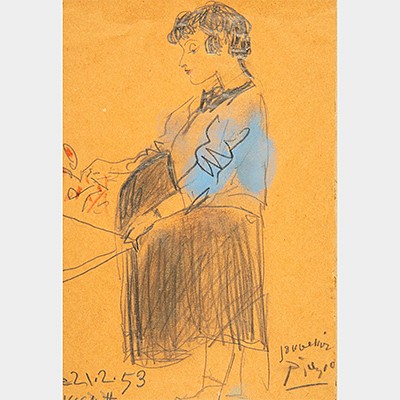ANTONI CLAVÉ I SANMARTÍ (Barcelona, 1913 - Saint Tropez, France, 2005). "La ninfa constante, 1934. Original work exhibited at the Capitol cinemas. Gou
Lot 86
About Seller
Setdart Auction House
Carrer Aragó 346
Barcelona
Spain
Setdart Subastas was born in 2004 and is currently the first online art auction in Spain with solidity, prestige and reliability guaranteed by our more than 60,000 users. Setdart has a young, dynamic and enterprising team ready to successfully manage the purchase and sale of art works through custom...Read more
Categories
Estimate:
EUR€12,000 - EUR€14,000
$12,500 - $14,583.33
Absentee vs Live bid
Two ways to bid:
- Leave a max absentee bid and the platform will bid on your behalf up to your maximum bid during the live auction.
- Bid live during the auction and your bids will be submitted real-time to the auctioneer.
Bid Increments
| Price | Bid Increment |
|---|---|
| EUR€0 | EUR€10 |
| EUR€200 | EUR€25 |
| EUR€500 | EUR€50 |
| EUR€1,000 | EUR€100 |
| EUR€3,000 | EUR€200 |
| EUR€5,000 | EUR€500 |
| EUR€10,000 | EUR€1,000 |
| EUR€20,000 | EUR€2,000 |
| EUR€50,000 | EUR€5,000 |
About Auction
By Setdart Auction House
Sep 20, 2021
Set Reminder
2021-09-20 08:00:00
2021-09-20 08:00:00
America/New_York
Bidsquare
Bidsquare : CONTEMPORARY ART
https://www.bidsquare.com/auctions/setdart-auction-house/contemporary-art-7482
Setdart Auction House sofia@setdart.com
Setdart Auction House sofia@setdart.com
- Lot Description
ANTONI CLAVÉ I SANMARTÍ (Barcelona, 1913 - Saint Tropez, France, 2005). "La ninfa constante, 1934. Original work exhibited at the Capitol cinemas. Gouache and collage on paper adhered to canvas. Signed in the central right area. Attached letter from the Clavé Archives confirming the authenticity of the work. Work reproduced in "Cartells per als cinemes de Barcelona, 1933-1935", VV.AA., Sala Gaspar, November 1990, p. 42. Measurements: 233 x 110 cm. Antoni Clavé was, along with Josep Renau, one of the most famous artists in the genre of 20th century Spanish film poster design. At the age of just 22, the Catalan held the title of "the most genuine exponent of Barcelona poster art", and was also considered by the German magazine Gebrauchsgraphik to be "the most popular poster artist in the Catalan capital". Years before the present work was produced, between 1931 and 1933, Antoni Clavé had already received numerous awards for his contribution to the world of cinema. Among other creations, his brilliant posters and oil paintings on plywood were displayed on the façades of the main cinemas in Barcelona, such as the Cine Capitol and the Catalonia. Specifically, Clavé created the poster in question to decorate the walls of the Capitol cinema, following the premiere of the film "The Constant Nymph" in 1934. The film, an adaptation of the novel of the same name written by Margaret Kennedy in 1924, tells the story of Tessa (Victoria Hopper), a young Belgian schoolgirl who falls in love with the world-famous composer Lewis Dodd (Brian Aherne). Antoni Clavé is one of the most important figures in Spanish contemporary art. Trained at the San Jordi School of Fine Arts in Barcelona, Clavé initially devoted himself to advertising graphics, illustration and the decorative arts. In 1936 he took an active part in the Civil War, joining the Republican ranks, which led him to go into exile in France at the end of the war. That same year, 1939, he exhibited the drawings he had made on the battlefields. He settled in Paris, where he met Vuillard, Bonnard and Picasso. He already enjoyed great international prestige at the time when he began to be recognised in Spain, with his exhibition at the Sala Gaspar in Barcelona in 1956. At the same time he produced illustrations for the work "Gargantua and Pantagruel", which led him to become familiar with medieval iconography. It was in the 1950s that he began his intense work in the world of ballet and theatre, achieving great fame in the world of international stage design. In 1952 he made the sets for the film "Hans Christian Andersen", by Charles Vidor, and was nominated for an Oscar award. In 1954 he abandoned set design to devote himself to painting. He was awarded prizes at the Hallimark in New York in 1948, at the Venice Biennale in 1954 and at the Tokyo International Biennale in 1957. In 1984 the Spanish state recognised his artistic value with the exhibition of more than one hundred of his works in the Spanish pavilion at the Venice Biennale. That same year he was awarded the Gold Medal of the Generalitat de Catalunya. Clavé's work can be found, among many others, in the Bilbao Fine Arts Museum, the Tate Gallery, the Museum of Modern Art in Paris, the British Museum in London, the Museum of Modern Art in Tokyo and the Reina Sofía Museum in Madrid.
- Shipping Info
-
In-house shipping available. Please inquire at admin@setdart.com.
-
- Buyer's Premium



 EUR
EUR CAD
CAD AUD
AUD GBP
GBP MXN
MXN HKD
HKD CNY
CNY MYR
MYR SEK
SEK SGD
SGD CHF
CHF THB
THB
















